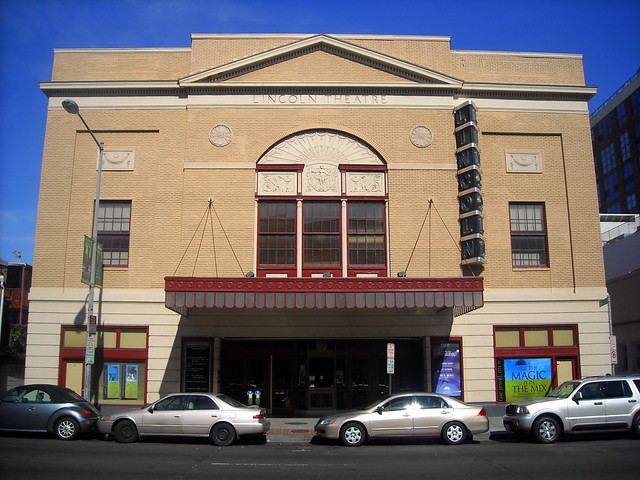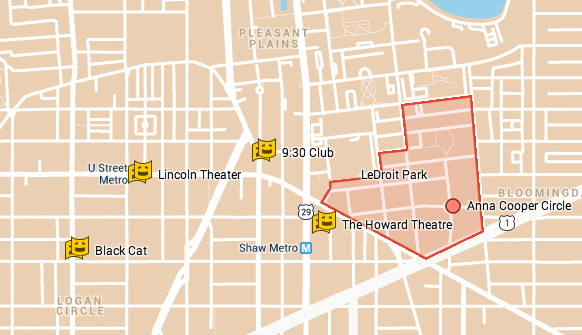The Lincoln Theater is back in business

Photo by NCinDC on Flickr
The Post reports that music venue owner IMP, which operates the 9:30 Club and Merriweather Post Pavilion, is now managing the District-owned Lincoln Theater.
As we noted before, the Lincoln Theater’s revival in the 1990s failed to measure up to the Howard Theatre’s recent rebirth. Last year we compared the number of scheduled events at both theaters from May 11 to June 30, 2012. The contrast was stunning as the Howard had announced 51 scheduled events compared to the Lincoln’s paltry five.
The District’s new operator for the Lincoln has already booked comedians Ira Glass and Cheech and Chong, as well as musical performers Janelle Monae, Soundgarden’s Chris Cornell, and KT Tunstall for next month.
The Lincoln is just one of four big venues within a mile of LeDroit Park:
| Theater | Distance | Capacity |
|---|---|---|
| Howard Theatre | 0.3 mi | 600 if seated; 1,000 if standing |
| 9:30 Club | 0.6 mi | 1,200 standing |
| Lincoln Theater | 0.8 mi | 1,225 seated |
| Black Cat | 1.0 mi | 700 standing and 200 in the backstage |
The Lincoln Theater’s 1,225 fixed seats set the venue apart. Though this configuration limits the types of acts that will perform, it also guarantees each patron a reserved space.
Check out the Post’s handy comparison chart, including typical headliners and food options for each venue.
The Lincoln vs. the Howard: What a difference operations make

The revival of the Howard Theatre brought worry that our newly revived venue would follow the disappointing path of the Lincoln Theatre on U Street. After all, both theaters were built in the early 20th century, both are owned by the DC government, and both are located within a short walk of each other.
A glance at both theaters’ online schedules reveals that their fates have sharply diverged. From now until the end of June, the Lincoln Theatre has 5 events scheduled while the Howard has 51.
This glaring disparity shows the importance of selecting the right management team. The District chose the experienced Blue Note Entertainment Group to run the Howard while it chose the non-profit U Street Theatre Foundation to run the Lincoln. The mayor’s office rightly revoked U Street Theatre Foundation’s contract for the Lincoln as the theatre was careening toward bankruptcy at the end of 2011. The mayor has tasked the DC Commission on the Arts and Humanities with finding a new operator for the Lincoln.
The greater U Street area is a regional arts venue. The Howard Theatre, the 9:30 Club, U Street Music Hall, the Black Cat, Bohemian Caverns, Twins Jazz Club, and numerous performance-oriented bars provide an amount of live performance space most cities would envy. But when we compare the success of these venues to the fiasco of the Lincoln Theatre, it becomes clear that something is terribly wrong in the District’s stewardship of this resource. If all of these venues can thrive, so can the Lincoln.
City Paper contrasts the Howard and the Lincoln
We wrote before about how the Howard Theatre differs significantly from the often-dark Lincoln Theatre on U Street. Now the City Paper published a longer essay contrasting the theaters and showing that the Howard will not repeat the mistakes of the Lincoln. According to the City Paper, there are six main reasons that the Howard will likely succeed where the Lincoln failed:
- The Howard will book a variety of popular acts, including acts that typically perform elsewhere.
- A professional management company with a history of running music clubs will manage the theater.
- The Howard can convert from a standing-room venue to a seated supper club in a flash. The Lincoln Theater’s seats, by contrast, cannot be removed.
- The Howard will serve much more food and, more importantly, alcohol, which is where profits are made in the restaurant business.
- The District government, though holding title to the property, has little influence in its operations.
- The Howard has better developed PR and marketing strategy.
Will the Howard Theatre go the same way as the Lincoln Theatre?
Will the Howard Theatre, soon to open in April, end up bankrupt like the Lincoln Theatre on U Street? Both are historic U Street area theaters that were revived at significant public expense. Both are owned by the District government and are under the control of non-profits.
There are, however, some significant differences between the Lincoln and the Howard: the floor, the kitchen, and the management.
The Lincoln Theatre is a traditional theater with fixed rows of seats. This makes the venue unsuitable for a variety of performances. All concert venues nearby have few if any seats— just an open floor where patrons stand.
The Howard Theatre’s floor is a little different. The theatre will have few permanent seats. Much of the space will contain seats and tables for the performances where food is served, such as the weekly gospel brunch, a comedy show, or certain jazz performances.
When tables are unsuitable for the type of performance, they will be stowed beneath the stage, thus opening up the first floor like the 9:30 Club or the Black Cat. This flexibility allows the venue to attract a greater variety of acts.
Another important difference is that the Howard Theatre will contain a large kitchen. Food service, particularly on the sale of alcohol, is where the venue will make money. The Lincoln Theatre’s food and liquor operation can’t compare.
Finally, while the Lincoln Theatre was managed (or mismanaged, some say) by an ad hoc non-profit, the Howard Theatre will be run by Blue Note Jazz Clubs, which runs the Blue Note Jazz Club, the Highline Ballroom, and B.B. King Blues Club & Grill in New York. This gives us confidence that a similar success can happen at the Howard.
7th & T was always the seedier end of the U Street corridor
This is the second in a series on the Scurlock photo archive. Read the first entry.
During the Jazz Age of the 1920s and later into the 1930s, U Street was dubbed the “black Broadway” as it featured such venues as the Lincoln Colonnade (now the Lincoln Theater), the Howard Theatre, and other clubs and restaurants. In a segregated city in which blacks were excluded from most restaurants, theaters, and stores, U Street served as a refuge to catch a show and enjoy a meal.
This photo from the Scurlock archives was taken looking east at 7th and T Streets NW in 1939.
[Toggling between now and then photos will not work in RSS readers. View the actual post]
We have referred to this area as the block of blight for its dilapidated buildings, copious litter, and frequent police arrests. It turns out that some things never change. Even when this photograph was taken, U Street was not uniform in character and the area around the Howard Theatre was considered downscale compared to the classier venues west on U Street. (For more on U Street’s evolution, see Blair Ruble’s recent book, Washington’s U Street: A Biography.)
Pictured here at the corner is National Grill, which, like Harrison’s Café in LeDroit Park, advertised itself as open all night. The lighted vertical sign attached to the façade appears to read “LUNCH” and the pediment at the cornice bears the building’s name, “Scott’s”. (View a larger version of the photo.)
Just to the right (south) of National Grill is the S.W. Keys Luncheonette, whose vertical sign advertises coffee and waffles. Just south of that is Harlem Cafe, located in a building that has since been replaced.
On T Street, just behind Scott’s Building and just before the Howard Theatre, you will see a sign that reads “BILLIARDS”. That marks Frank Holliday’s pool hall, a popular gathering spot for Howard scholars, jazz musicians, and city laborers alike. Duke Ellington captured the scene at the pool hall:
Guys from all walks of life seemed to converge there: school kids over and under sixteen; college students and graduates, some starting out in law and medicine and science; and lots of Pullman porters and dining-car waiters.
Just beyond the pool hall, you’ll see the Howard Theatre sporting its original Italianate façade. The theater was later covered with plaster, which was only recently removed for the restoration project.
Today the last two buildings on 7th Street are a Chinese take-out and a tiny market. One of the developers of Progression Place, the large development project underway on the block (rendering below), said that the late owner of these two buildings refused to sell to his development. Progression Place will incorporate every building on this block except for these two.
If anyone is looking for a two-building restoration project, here is your chance!











Recent Comments